
Muskoka’s watersheds stand at a crucial turning point. While currently healthy, they are gradually degrading in several ways, and our existing management systems seem incapable of halting or reversing this negative trend. We need an integrated, watershed-scale management system capable of dealing with the multiple stresses our iconic environment now faces.
About the Muskoka Report Card
The Muskoka Watershed Report Card, produced every five years by the Muskoka Watershed Council, scientifically assesses Muskoka’s watershed health. It educates residents and decision-makers about water and land conditions, enabling sustainable practices to bolster the strength of our remarkable natural environment. This is essential for our way of life and economy.
This summary Report Card below captures key highlights. Read the full Background Report for in-depth insights.
What is Watershed Health?
A watershed is a living and intricate ecosystem capable of maintaining its structure and functions unless faced with excessive stresses. Its health, or ecological integrity, signifies how effectively it preserves its typical structure and functions. Similar to how medical experts gauge human health, we measure watershed health by analyzing diverse indicators.
Muskoka’s Watersheds
This Report Card covers the entire Muskoka River Watershed (in blue), as well as a small portion of the South Georgian Bay Shoreline (in red) and parts of the Severn River-Lake Simcoe Watershed (in green) that intersect with the District of Muskoka. This vast 7,000 km2 area spans over 210 km from the Algonquin Highlands to Georgian Bay, including approximately 2,000 lakes amid extensive forests.
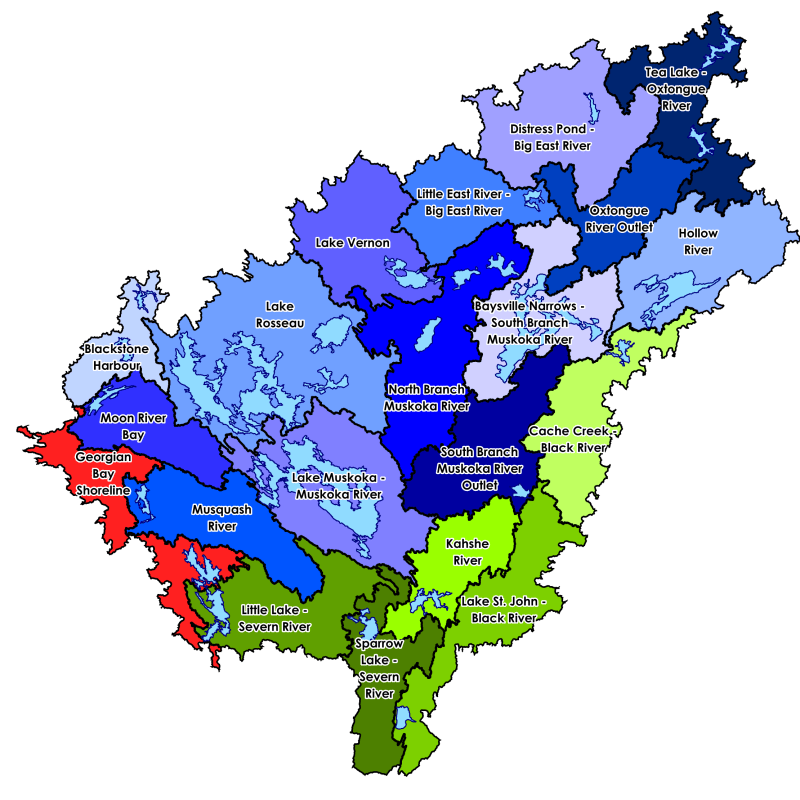
Report Card Highlights
Dive Deeper into the Background Report
Or skip to a specific chapter:
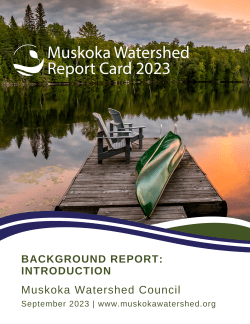
Introduction
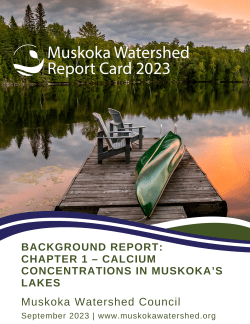
Chapter 1 – Calcium Concentrations in Muskoka’s Lakes
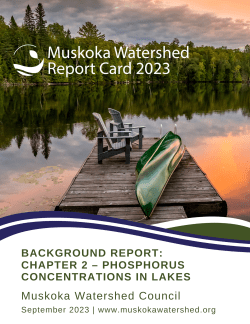
Chapter 2 – Phosphorus Concentrations in Lakes
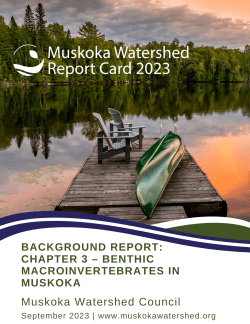
Chapter 3 – Benthic Macroinvertebrates in Muskoka
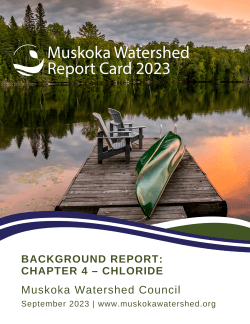
Chapter 4 – Chloride
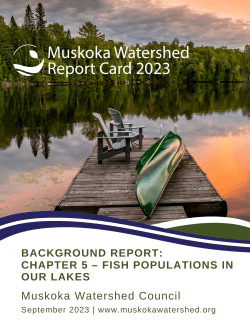
Chapter 5 – Fish Populations in our Lakes
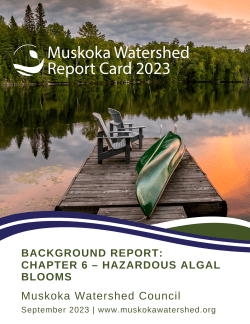
Chapter 6 – Hazardous Algal Blooms
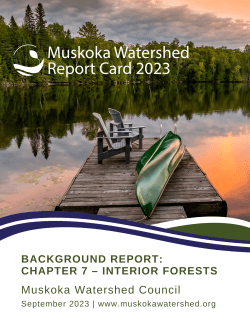
Chapter 7 – Interior Forests
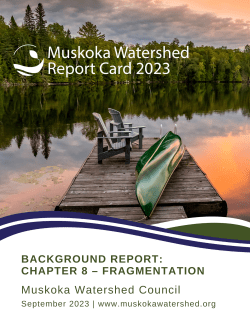
Chapter 8 – Fragmentation
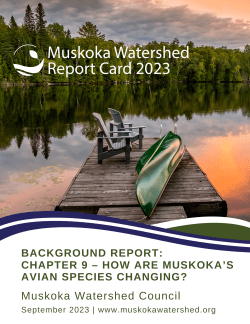
Chapter 9 – How are Muskoka’s Avian Species Changing?
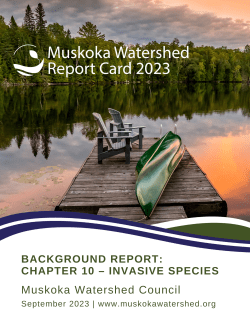
Chapter 10 – Invasive Species
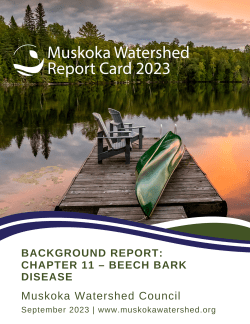
Chapter 11 – Beech Bark Disease
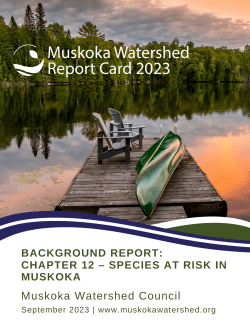
Chapter 12 – Species at Risk in Muskoka
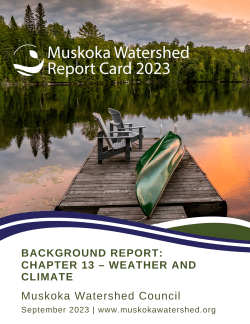
Chapter 13 – Weather and Climate
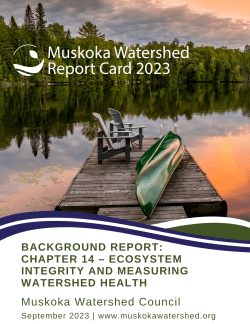
Chapter 14 – Ecosystem Integrity and Measuring Watershed Health
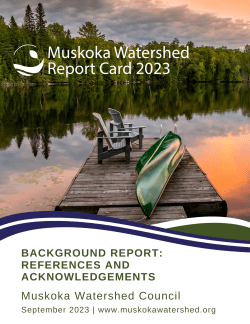
References and Acknowledgements
How Can You Help?
- Advocate for Integrated Watershed Management (IWM) for healthier watersheds.
- Combat climate change, reduce emissions, and champion sustainability.
- Speak out: Encourage leaders to make tough choices for a healthier environment. Local actions
alone can’t solve complex issues. - Engage: Volunteer or support local environmental groups.
- Minimize salt use to protect water.
- Clean boats, remove invasive plants, inspect equipment, and avoid bait dumping. Learn more at https://www.ontario.ca/page/invasive-species-action-plans.
- Report invasive species, erosion, and algae blooms to authorities.
- Protect shorelines with native plants and use phosphate-free cleaners; avoid fertilizers.
- Log bird sightings on eBird.
- Enroll in the forest tax incentive program for land stewardship.
- Join the Biological Monitoring Program as a Citizen Scientist.
- Support calcium restoration through the Ash Muskoka Program.
- Find more ideas in the “Living in Cottage Country” handbook by Muskoka Watershed Council. Visit
www.muskokawatershed.org/resources/handbook for resources to support your actions.
Learn More: The State of our Watershed Series
- The state of our environment: MWC responds to the challenge.
- Valuable wetlands in Muskoka deserve our care
- How healthy are our forests in Muskoka?
- Muskoka’s iconic lake trout need help in face of warmer water, new species in area lakes
- Will loons still call across Muskoka in 30 years?
- Is biodiversity declining in Muskoka?
- What are the bugs in the mud of Muskoka area lakes telling us?
- Phosphorus can be cleaned up from Muskoka’s lakes
- Less ice cover in Muskoka impacts winter sports and could mean ‘more dried up wetlands and streams’
- Harmful algal blooms: What is the cause and what can Muskoka residents do?
